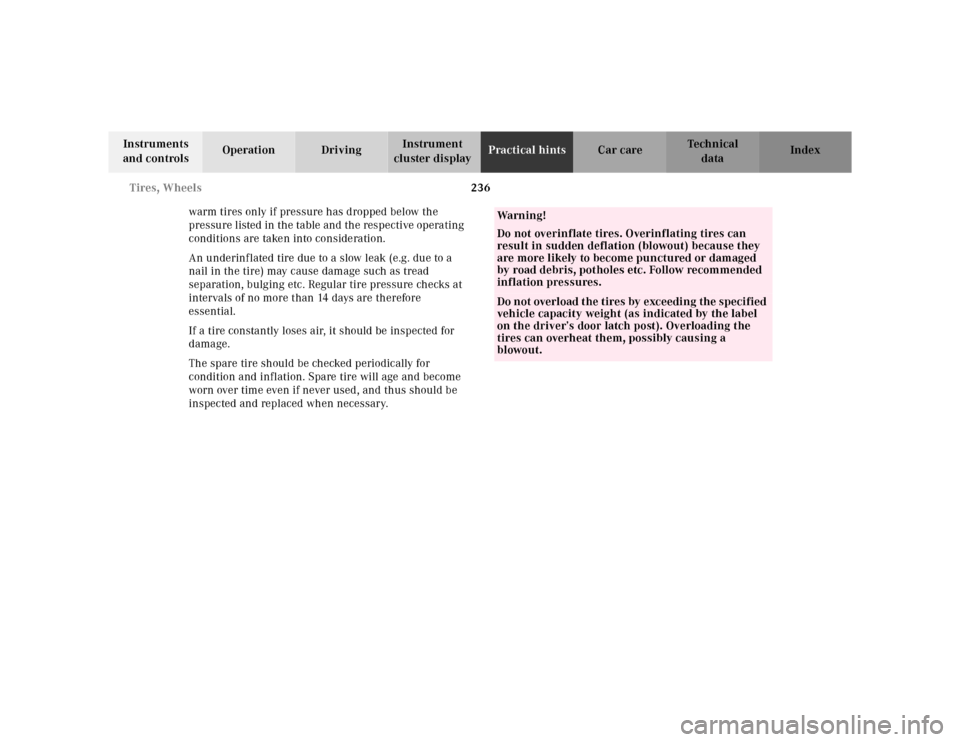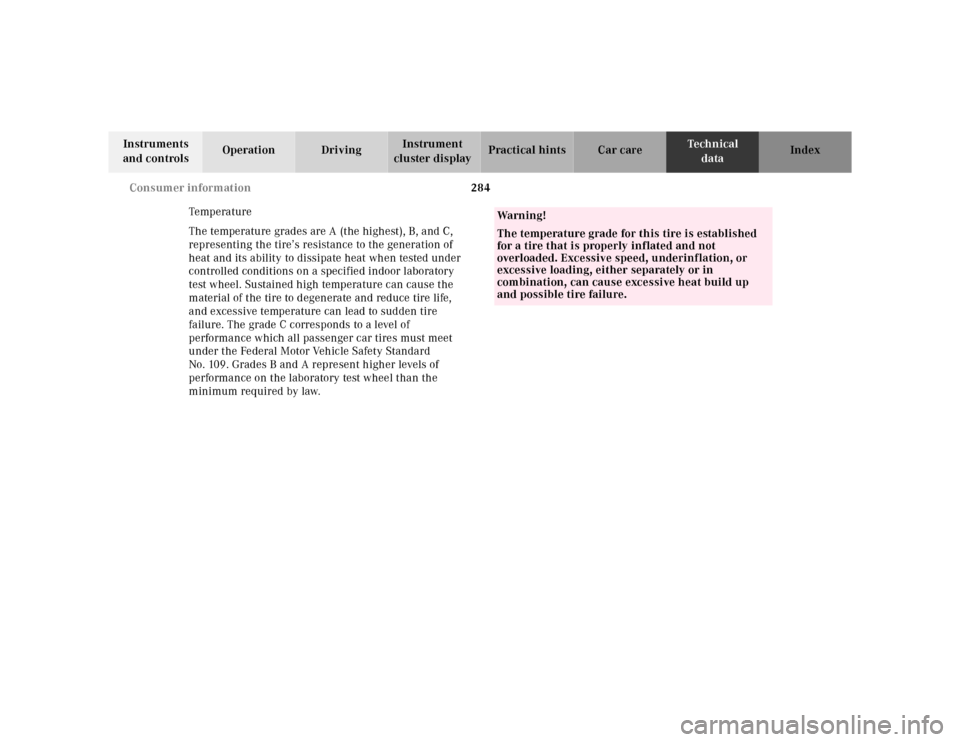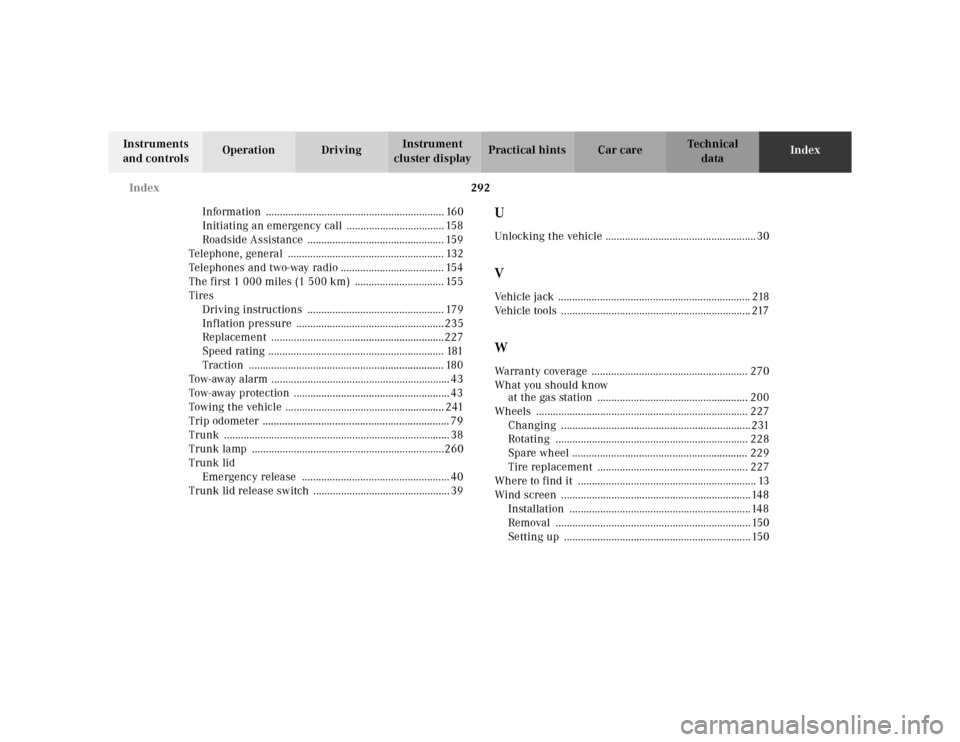Page 240 of 302

236 Tires, Wheels
Te ch n ica l
data Instruments
and controlsOperation DrivingInstrument
cluster displayPractical hintsCar care Index
warm tires only if pressure has dropped below the
pressure listed in the table and the respective operating
conditions are taken into consideration.
An underinflated tire due to a slow leak (e.g. due to a
nail in the tire) may cause damage such as tread
separation, bulging etc. Regular tire pressure checks at
intervals of no more than 14 days are therefore
essential.
If a tire constantly loses air, it should be inspected for
damage.
The spare tire should be checked periodically for
condition and inflation. Spare tire will age and become
worn over time even if never used, and thus should be
inspected and replaced when necessary.
Wa r n i n g !
Do not overinflate tires. Overinflating tires can
result in sudden deflation (blowout) because they
are more likely to become punctured or damaged
by road debris, potholes etc. Follow recommended
inflation pressures.Do not overload the tires by exceeding the specified
vehicle capacity weight (as indicated by the label
on the driver’s door latch post). Overloading the
tires can overheat them, possibly causing a
blowout.
Page 288 of 302

284 Consumer information
Te ch n ica l
data Instruments
and controlsOperation DrivingInstrument
cluster displayPractical hints Car care Index
Temp era tur e
The temperature grades are A (the highest), B, and C,
representing the tire’s resistance to the generation of
heat and its ability to dissipate heat when tested under
controlled conditions on a specified indoor laboratory
test wheel. Sustained high temperature can cause the
material of the tire to degenerate and reduce tire life,
and excessive temperature can lead to sudden tire
failure. The grade C corresponds to a level of
performance which all passenger car tires must meet
under the Federal Motor Vehicle Safety Standard
No. 109. Grades B and A represent higher levels of
performance on the laboratory test wheel than the
minimum required by law.
Wa r n i n g !
The temperature grade for this tire is established
for a tire that is properly inflated and not
overloaded. Excessive speed, underinflation, or
excessive loading, either separately or in
combination, can cause excessive heat build up
and possible tire failure.
Page 296 of 302

292 Index
Te ch n ica l
data Instruments
and controlsOperation DrivingInstrument
cluster displayPractical hints Car careIndex
Information ................................................................ 160
Initiating an emergency call ................................... 158
Roadside Assistance ................................................. 159
Telephone, general ........................................................ 132
Telephones and two-way radio ..................................... 154
The first 1 000 miles (1 500 km) ................................ 155
Tires
Driving instructions ................................................. 179
Inflation pressure .....................................................235
Replacement ..............................................................227
Speed rating ............................................................... 181
Traction ...................................................................... 180
Tow-away alarm ................................................................ 43
Tow-away protection ........................................................ 43
Towing the vehicle ......................................................... 241
Trip odometer ................................................................... 79
Trunk ................................................................................. 38
Trunk lamp .....................................................................260
Trunk lid
Emergency release ..................................................... 40
Trunk lid release switch ................................................. 39
UUnlocking the vehicle ...................................................... 30VVehicle jack ..................................................................... 218
Vehicle tools .................................................................... 217WWarranty coverage ........................................................ 270
What you should know
at the gas station ...................................................... 200
Wheels ............................................................................ 227
Changing ....................................................................231
Rotating ..................................................................... 228
Spare wheel ............................................................... 229
Tire replacement ...................................................... 227
Where to find it ................................................................ 13
Wind screen ....................................................................148
Installation .................................................................148
Removal ...................................................................... 150
Setting up ................................................................... 150